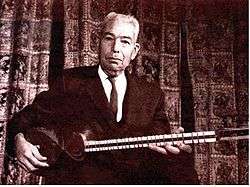Ali-Akbar Shahnazi

Ali-Akbar Shahnazi (1897 – March 1985) was an Iranian musician and master of the tar.
Biography
Ostad Ali Akbar Shahnazi was born in Tehran, Iran in 1897. His father, Mirza Hossein Gholi, the great master of tar named him Ali Akbar according to a very old tradition: the grandson should be named as his grandfather. His grandfather the Ali Akbar Khan of the Farahan village of the Arak city was a great master of tar. One day after a quarrel with his neighbor the grandfather went to the roof to play with his tar named Ghalandar. The next day he was found dead on the roof.
Shahnazi started learning tar from his father at the age of seven. After five years he reached the level that he was able to teach some of his father's students. At the age of 14 he recorded two gramophone disks playing noted Persian melodies, with Avaz-e-Afshari and Avaz-e-Bayat-e-Tork accompanying the vocalist Jenab Damavandi. At the age of 18, after his father died, he became responsible for teaching his father's students. He established the Shahnazi Music School in 1929.
He recorded many pieces with noted vocalists of his time such as Eghbal Azar and Nakisa. He collaborated with other masters of his time such as Reza Mahjubi (violinist) and Hosain Tehrani (father of modern tonbak). He not only taught his students his father's radif, but also composed a beautiful radif and called it radif-e-dore-ye-ali and taught it to his students too.
Shahnazi comes from a music family called in Persian Khandan-e-Honar that literally means art dynasty. His younger brother Abdolhossein was a very good tar player. Their uncle Mirza Abdollah was a great teacher of setar. Ali Akbar Khan's nephew the Gholam Hossein Khan was another tar player.
He recorded his father's radif in 1962, and his own radif in 1977.
Shahnazi died in March 1985 at the age of 88.
References
- Haghighat, A., Honarmandan e Irani az Aghaz ta Emrooz, Koomesh Publication, 2004, (in Persian)
- Khaleghi, R., Sargozasht e Musighi e Iran, Ferdowsi Publication, 1955, (in Persian)